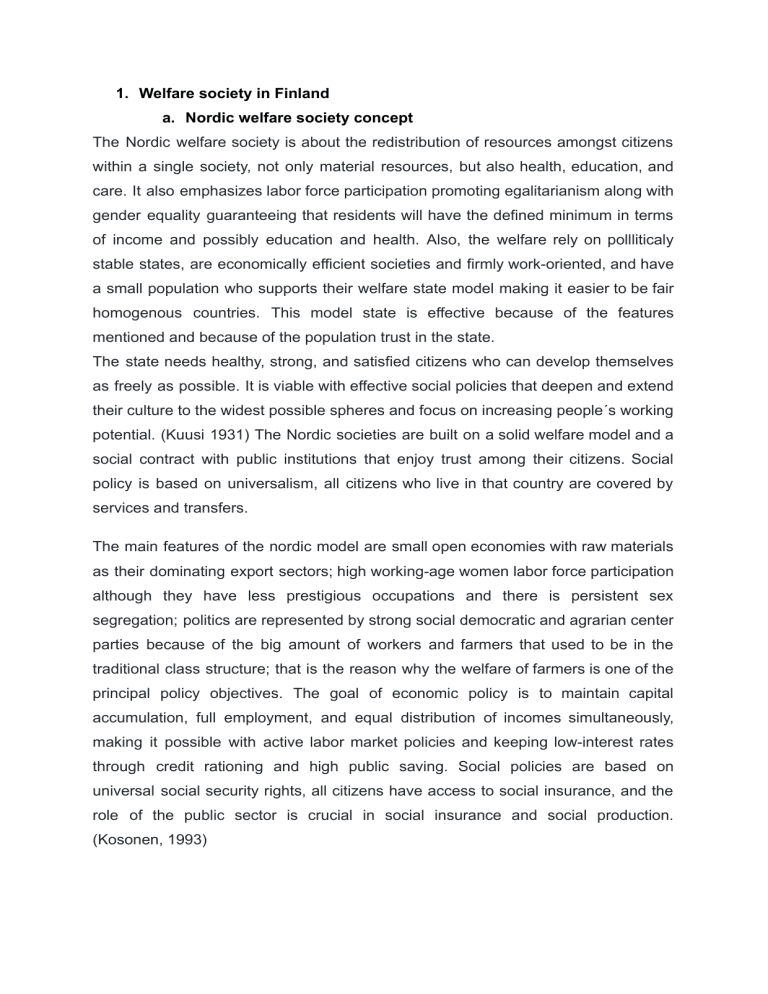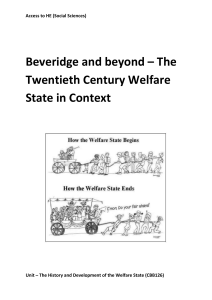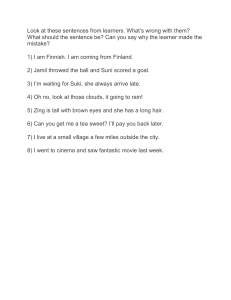
1. Welfare society in Finland a. Nordic welfare society concept The Nordic welfare society is about the redistribution of resources amongst citizens within a single society, not only material resources, but also health, education, and care. It also emphasizes labor force participation promoting egalitarianism along with gender equality guaranteeing that residents will have the defined minimum in terms of income and possibly education and health. Also, the welfare rely on pollliticaly stable states, are economically efficient societies and firmly work-oriented, and have a small population who supports their welfare state model making it easier to be fair homogenous countries. This model state is effective because of the features mentioned and because of the population trust in the state. The state needs healthy, strong, and satisfied citizens who can develop themselves as freely as possible. It is viable with effective social policies that deepen and extend their culture to the widest possible spheres and focus on increasing people´s working potential. (Kuusi 1931) The Nordic societies are built on a solid welfare model and a social contract with public institutions that enjoy trust among their citizens. Social policy is based on universalism, all citizens who live in that country are covered by services and transfers. The main features of the nordic model are small open economies with raw materials as their dominating export sectors; high working-age women labor force participation although they have less prestigious occupations and there is persistent sex segregation; politics are represented by strong social democratic and agrarian center parties because of the big amount of workers and farmers that used to be in the traditional class structure; that is the reason why the welfare of farmers is one of the principal policy objectives. The goal of economic policy is to maintain capital accumulation, full employment, and equal distribution of incomes simultaneously, making it possible with active labor market policies and keeping low-interest rates through credit rationing and high public saving. Social policies are based on universal social security rights, all citizens have access to social insurance, and the role of the public sector is crucial in social insurance and social production. (Kosonen, 1993) b. What principles and values guide the welfare in Finland? The principles and values that guide welfare in Finland are universalism and guaranteeing individuals and their families a minimum income, decreasing the number of insecurities by giving protections in case of social risks, and ensuring all citizens to the agreed social services. In Finnish political life, agricultural interests are vital and characterized by regulation and corporatism. The ideals of economic policy are a high investment, economic growth, and a competitive export sector. These principles guide the future and direction of welfare. c. Common features of Nordic welfare societies, especially the model of the Finnish welfare society. We can find some features in the Finnish model with some distinctiveness compared with the nordic model, for example, in the central status of export competitiveness and intention of interest meditation which are based on industrial structure. The relevance of the agricultural sector is because of the late industrialization and connections between forest owners and the forest industry. Agrarian interests have been well served in all political settlements and the state puts effort to guarantee competitiveness through devaluations of the dominating export sector, the forest industry. In Finland the agricultural interest and position of the Center party have been more dominant than in the other Nordic countries, workers are well organized in labor unions and labor parties, but the fragmentation of the Finnish left makes it unable to generate a powerful hegemonic project. Because of the leading role of the Center Party the agrarian interest, it is more powerful than in the other nordic countries and the export sector has been assigned as a high priority in economic policy. They have generated a comprehensive system of meditation where all important interest groups are involved, the political coalitions must maintain the support of decisive class groups. Regulation and corporatism characterize Finnish political life. The state has to guarantee the arrangements of capital accumulation and economic growth, respect what is taken as economic necessities, and assure the performance of the export sector, in this sense the state and role of politics are weaker than in Norway or Sweden because the principal aims of Finnish economic policy include high investment, economic growth, and competitive export sector, so it may be necessary to ignore the aims of full employment and stability of economic development. Focusing on the export sector can make fiscal and monetary policy tight, money devaluation, a wage freeze, and unemployment if the export sector shows weakness. Finnish social policy is more dominated by economic necessities than other Nordic countries and social benefits are developed by the corporatist interest meditation. We can find that nordic characteristics such as universalism and redistribution are reinforced in the Finnish model, universal social rights are developed according to the citizenship principles but due to the increasing strength of the trade unions and middle class, they have created parallel income-related systems. Also, financial transfers and services are extended to all the important interest groups, so they get their share. (Kosonen, 1993) d. Changes in Finnish welfare society. In the 1960s, there were a lot of changes in the Finnish institutional welfare state which made Finland share some differences with other Nordic countries. People moved from the countryside to cities and Sweden while also women started to work more and to be educated. They implemented a Finnish social policy towards the tradition of a universal and institutional welfare state. Also, Pekka Kuusi underlined the importance of the maximal utilization of the potential labour force, which is now one of their main principles. There was a need for reforms in the daycare system, family benefits, and housing policies. After the change in welfare services, the third sector, families and public authorities needed to be involved in supplying welfare services. In 1991 the Soviet Union collapsed, and it had an impact on the Finnish economy. Also the period of global competition society (2000-) makes the future and policies uncertain. There were also changes towards gender and social equality. Finland is a gender equality pioneer. In 1880 they established the first women’s association. Six years later was opened the first coeducational school was. The first women joined in 1873. Finland was the first country where women had full political rights, which was in 1906, and later on, in 1919, married women had the right to work in paid employment without needing the consent of their husbands. In the sixties, gender equality activists spoke out about sharing care responsibilities, and daycare for children started to be provided by law. In the seventies, abortion became legal for social reasons, and women could keep their surnames in the names act. Until the eighties, women could become a priest, not only men. Finland was also a pioneer in having the first female Minister of defence in the world in 1990. The development of social security and the pension system benefitted women and strengthened society’s gender equality making able to be more aware of social injusticies. e. Critics about the system Nowadays the role of the state in Finland it is not as strong as it used to be, the crisis began in the 1990s when its GDP dropped about 14% and unemployment rose from 3 to almost 20%. (Honkapohja, S. Koskela, E. 1999) Although the deep depression that Finland went through, they still have social secure system, education, culture, and social and health services. But it is not as efficient as it is need. It is necessary a health and social services reform because currently, not all people have equal access to health services, lot of them may need to wait for access to care and services; Finnish population is aging and the need for proper care is increasing; the working-age population will decline due to the birth rate is falling; tax revenue will decrease year by year. This reform has the goal to preserve equal and quality health and social services for all. This reform will restructure the organization of public healthcare and social welfare in Finland which includes: primary and specialized healthcare; hospital services; dental care; mental health and substance abuse services; social work for adults; maternity and child health clinics; child welfare; housing services for older people; services for people with disabilities; home care; rehabilitation. The enforcement of the reform pretends to give a greater variety of locally accessible services; influence social and health services; make it possible to people to get help fast and early on; offer efficient urgent care and support. Also, it focuses on promoting the right to use your mother tongue and the possibility of receiving an interpretation. In case of losing the ability to work, citizens can get support for their workability and functional capacity. Families with children will have easily accessible and close-located services that provide different kinds of parenting support. It will be digital access to health and social services to save time and travel. After the reform, the responsibility for social, health, and rescue services duties will rest in 21 more organizers in addition to Helsinki. (Soteuudistus, 2022) 2. Pregnancy and children in Finland a. How is being pregnant and having a child in Finland. Maria is a pregnant Finnish citizen who does not know how she can get support for her situation in Finland and what help she can receive. As social workers, we will develop all the necessary and useful information that she needs to know and can be helpful to her. First, we will write about maternity clinics, pregnancy certificates, childbirth, maternity and paternity leave, special maternity and parental cases, the required conditions to receive the benefits and how to claim them. Then about child benefits, the requirements to obtain them, how much it is and how to claim it. The first thing that you need to do is to book an appointment at the nearest maternity clinic or family centre. They will monitor your health and the baby’s health and give you information for a safe pregnancy and childbirth. After 154 days of pregnancy, you can ask the clinic for the pregnancy certificate, which will be necessary to present to apply for pregnancy leave from your employer, for the maternity grand and the pregnancy allowance from Kela. In the case of having been subjected to genital mutilation is recommended to tell the nurses about it because they can offer you an opening operation to make it easier to give birth. It can be done, in the beginning, during mid-pregnancy and childbirth. If you are afraid of giving birth, the maternity clinic can lead you to the Fear of Childbirth Outpatient Clinic, where they will help you. In Finland, women usually give birth in a hospital and the traditional way because it is the safest way. It can be done with a C-section if the doctor thinks it is necessary and safer for the baby and the mother. During laboring, you can be with your partner and another relative or friend, who will also stay with you at the hospital, helping you during the next few days. If it is your first child, he can spend the nights with you. After the child is born, you will have to register the baby in the population information system, the Finnish act on Forenames and Surnames and the child’s social security. Kela provides different benefits to families with children: maternity grant, special maternity allowance, paternity allowance, parental allowance, child benefit, child care allowances, benefits for ill or disabled children and child maitenance allowance. In the following picture, we can see how much time and when the benefits that Kela can pay for the families and children are available. At the top is the age of the child and in the left the column with the benefits paid by Kela. Figure 1. When are the benefits available? (Kela, 2021) As a mother, when you just had a baby you receive a maternity gran in form of a maternity package or as a tax-free lump sum fo 170 EUR, usually they choose the maternity package because it has a lot of necessary items and is more helpful. Maternity leave begins no earlier than 50 working days and no later than 30 working days prior to the expected due date. Once maternity leave starts, Kela, the Finnish social insurance institution, pays the maternity allowance for 105 working days. Even if during the pregnancy you have had to be absent from work before the actual period the special maternity allowance will not reduce the actual maternity allowance and you will be paid until it starts. Only if the job involves exposure to chemical substances, radiation or infectious diseases; work risk factors are unavoidable at work; and the employer cannot do any duties during the pregnancy, you can claim for the special maternity allowance. Paternity leave is after the birth of the child, it is for a maximum of 54 working days, he can be at home at the same time as the mother for 18 working days, and during the leave, Kella will pay a paternity allowance. After the maternity leave, one of the parents can take the parental leave that Kela will pay for 158 working days. If your child is seriously ill or disabled under 16, you can claim a special care aid because you will have to be temporarily absent from work without pay to take care of your children. The requirements tor receive the benefits are to live in Finland or be covered by the Finnish social security system. The mother has to had been covered by the Finnish social security for at least 180 days immediately before the estimated date of labor. The amount of the parental, maternity, special maternity and paternity allowances are determined according to the annual income bias. The reference period is 12 calendar months, before the month when the allowance is due. In case of receiving a daily fee, it can be paid according to the preceding benefit if you have been ill, studying or unemployed. If the claimant does not have any work income, it will be paid at the minimum levels. In Finland, families can receive child benefits determined by the number of children in the family. Kela pays child benefits for children under seventeen who live in Finland since he is born to the adult responsible for the child's care. When the child turns seventeen, moves abroad or starts receiving a disability pension, it finishes. The amount of the aid increases with the number of children, and the order of them increases the amount. For example one child is 94.88€ per month, for the second child 104.84€ and for the third 133.79€, etc. (Kela, 2022) If you are unmarried and not cohabitating with anybody the amount of money will increase. b. How it is compared to Spain In Spain since January 1st of 2021 the maternity and paternity leave are of 16 weeks, equal to 80 working days. Six of this weeks are uninterrupted after giving birth and both parents at the same time. The other 10 weeks leave, can be taken uniterrumped after the six weeks period. You can spread out the days to find the best way that suits your family life and helps your wellbeing. Also, you can make an agreement with the company where you work to choose be full or part time if it help you to coordinate your work and family life easly. You have 12 months to use your leave weeks. If is not your first child you or the baby has a disability it can be extended one more week for each parent. Now you can receive an aid for each child between 50 - 100€ if in the family there are two adults with one child and their anual income is under 27.000€, two adults with two childs with less than a 32.100€ annual income and one adult with one child with an annual income behind 25.700€ or 30.800 if tehy have more than one. Also, until the baby is nine months, both parents can have a lactation leave. They can reduce one hour every day during work hours, reduce half hour of the whole workday or accumulate one hour each day to sum a working free day. If you have more than three children, you are a single parent and have a disability of more or equal to 65%. You can claim economic aid of 1.000€, which is only given once. 3. Study visit: welfare management in Seinäjoki a. Description of the tasks The welfare service administration and supervision tasks in Seinäjoki are to find information about how welfare can be improve and what changes citizens need. Through the participation of different groups like the education sector, village and neighbourhood associations and communities, residents and community meet-ups, the administration can include their opinion in their decision and be aware of which actual changes the locals need to improve their life and wellness. It is crucial to know and hear what people needs. The administration also participates in national meetings with other Finnish administrations to exchange new ideas and come up with better projects. Based on the ideas exchanged and people's opinions, measures are develop. An example is that since 2021 they started to work on equality by setting up an equality program. To be able to set the relevant points and know people's opinions, they had group discussions with different groups like immigrants, young people, families and elderly people. b. Goals One of the main goals of the welfare service administration and supervision of Seinäjoki is to secure equal treatment of their residents and improve the citizens' well-being, making them interested in improving their well-being. The administration provides different activities and services in health, education, cultural and social sectors like outdoor gym, drama activities open for everybody and languages courses. They also develop measures to prevent elderly's people from accidents during winter or the population from feeling lonely. The objectives to enhancing well-being and health are to promote inclusion, commonality and cultural well-being. Improve the wellness of children, young people, families with children and senior citizens. Ensure that everybody can work and secure their livelihood; create an urban environment and culture that supports well-being. (Well-being Report of the City of Seinäjoki 2017–2020) 4. References Campos, Belén. (August 3rd of 2022 at 17:51). Las 10 ayudas públicas que te interesan si tienes o vas a tener un hijo. Levante: el mercantil valenciano. https://www.levante-emv.com/economia/2022/03/08/10-ayudas-publicas-que-interes an-si-tienes-hijos-63580661.html European Comission. (n.d.). Finland: Child benefit. Retrieved Desember 1, 2022 from https://ec.europa.eu/social/main.jsp?catId=1109&langId=en&intPageId=4515 European Comission. (n.d.). Finland: Maternity and paternity. Retrieved Desember 1, 2022 from https://ec.europa.eu/social/main.jsp?catId=1109&langId=en&intPageId=4514 Hautamäki, T. (September 2022). Introduction to welfare society. [PowerPoint slides]. SeAMK Moodle. Hautamäki, T. (19th September 2022). Towards welfare state. [PowerPoint slides]. SeAMK Moodle. Hautamäki, T. (September 2022). Welfare and politics. [PowerPoint slides]. SeAMK Moodle. Honkapohja, S. Koskela, E. 1 October 1999. The economic crisis of the 1990s in Finland. Economic Policy, Volume 14, Issue 29. (p. 400–436) and childbirth. plain language. https://doi.org/10.1111/1468-0327.00054 InfoFinland. (November 28th, 2022). Health: pregnancy https://www.infofinland.fi/en/health/pregnancy-and-childbirth Kela. (2021). Families with children: briefly and in https://www.kela.fi/documents/20124/411922/Families-with-children-brochure-Kela.p df/b8860aa6-8744-b854-4e01-71efe43e1636?t=1665119912434 Kela. (Desember 1st, 2022). Amount and payment of the child benefit. https://www.kela.fi/child-benefit-amount-and-payment Kosonen, P. (1993). The Finnish model and the welfare state in crisis. The Nordic welfare state as an idea and as reality. (5th ed.) The renevall institute, University of Helsinki. (p. 45-66) (Kuusi 1931) Seinäjoki. Health and social services: Promoting well-being. https://www.seinajoki.fi/en/health-and-social-services/promoting-well-being/ Seinäjoki. (2017). Well-being Report of the City of Seinäjoki 2017–2020. Soteuudistus. (October 7th, 2022 at 11.34h). What is the health and social services reform. https://soteuudistus.fi/en/health-and-social-services-reform




